oil filter BUICK LACROSSE 2005 Owner's Manual
[x] Cancel search | Manufacturer: BUICK, Model Year: 2005, Model line: LACROSSE, Model: BUICK LACROSSE 2005Pages: 410, PDF Size: 2.59 MB
Page 277 of 410
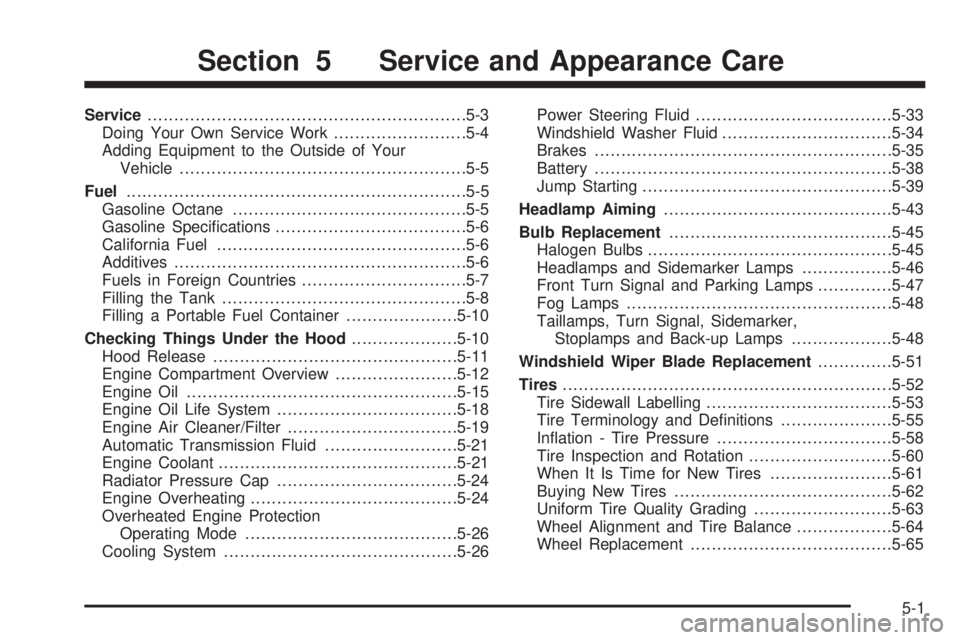
Service............................................................5-3
Doing Your Own Service Work.........................5-4
Adding Equipment to the Outside of Your
Vehicle......................................................5-5
Fuel................................................................5-5
Gasoline Octane............................................5-5
Gasoline Speci�cations....................................5-6
California Fuel...............................................5-6
Additives.......................................................5-6
Fuels in Foreign Countries...............................5-7
Filling the Tank..............................................5-8
Filling a Portable Fuel Container.....................5-10
Checking Things Under the Hood....................5-10
Hood Release..............................................5-11
Engine Compartment Overview.......................5-12
Engine Oil...................................................5-15
Engine Oil Life System..................................5-18
Engine Air Cleaner/Filter................................5-19
Automatic Transmission Fluid.........................5-21
Engine Coolant.............................................5-21
Radiator Pressure Cap..................................5-24
Engine Overheating.......................................5-24
Overheated Engine Protection
Operating Mode........................................5-26
Cooling System............................................5-26Power Steering Fluid.....................................5-33
Windshield Washer Fluid................................5-34
Brakes........................................................5-35
Battery........................................................5-38
Jump Starting...............................................5-39
Headlamp Aiming...........................................5-43
Bulb Replacement..........................................5-45
Halogen Bulbs..............................................5-45
Headlamps and Sidemarker Lamps.................5-46
Front Turn Signal and Parking Lamps..............5-47
Fog Lamps..................................................5-48
Taillamps, Turn Signal, Sidemarker,
Stoplamps and Back-up Lamps...................5-48
Windshield Wiper Blade Replacement..............5-51
Tires..............................................................5-52
Tire Sidewall Labelling...................................5-53
Tire Terminology and De�nitions.....................5-55
In�ation - Tire Pressure.................................5-58
Tire Inspection and Rotation...........................5-60
When It Is Time for New Tires.......................5-61
Buying New Tires.........................................5-62
Uniform Tire Quality Grading..........................5-63
Wheel Alignment and Tire Balance..................5-64
Wheel Replacement......................................5-65
Section 5 Service and Appearance Care
5-1
Page 289 of 410
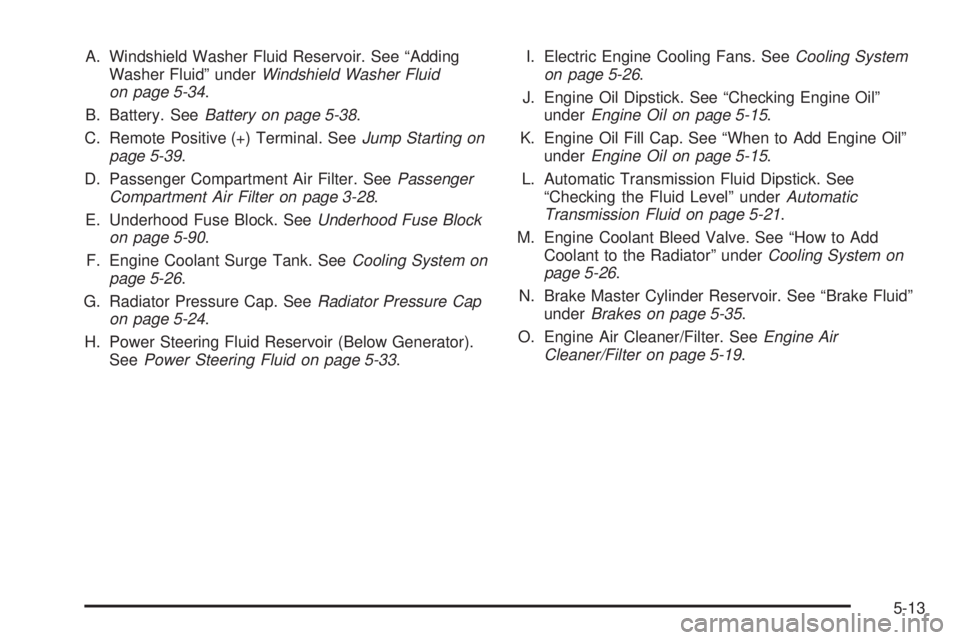
A. Windshield Washer Fluid Reservoir. See “Adding
Washer Fluid” underWindshield Washer Fluid
on page 5-34.
B. Battery. SeeBattery on page 5-38.
C. Remote Positive (+) Terminal. SeeJump Starting on
page 5-39.
D. Passenger Compartment Air Filter. SeePassenger
Compartment Air Filter on page 3-28.
E. Underhood Fuse Block. SeeUnderhood Fuse Block
on page 5-90.
F. Engine Coolant Surge Tank. SeeCooling System on
page 5-26.
G. Radiator Pressure Cap. SeeRadiator Pressure Cap
on page 5-24.
H. Power Steering Fluid Reservoir (Below Generator).
SeePower Steering Fluid on page 5-33.I. Electric Engine Cooling Fans. SeeCooling System
on page 5-26.
J. Engine Oil Dipstick. See “Checking Engine Oil”
underEngine Oil on page 5-15.
K. Engine Oil Fill Cap. See “When to Add Engine Oil”
underEngine Oil on page 5-15.
L. Automatic Transmission Fluid Dipstick. See
“Checking the Fluid Level” underAutomatic
Transmission Fluid on page 5-21.
M. Engine Coolant Bleed Valve. See “How to Add
Coolant to the Radiator” underCooling System on
page 5-26.
N. Brake Master Cylinder Reservoir. See “Brake Fluid”
underBrakes on page 5-35.
O. Engine Air Cleaner/Filter. SeeEngine Air
Cleaner/Filter on page 5-19.
5-13
Page 291 of 410
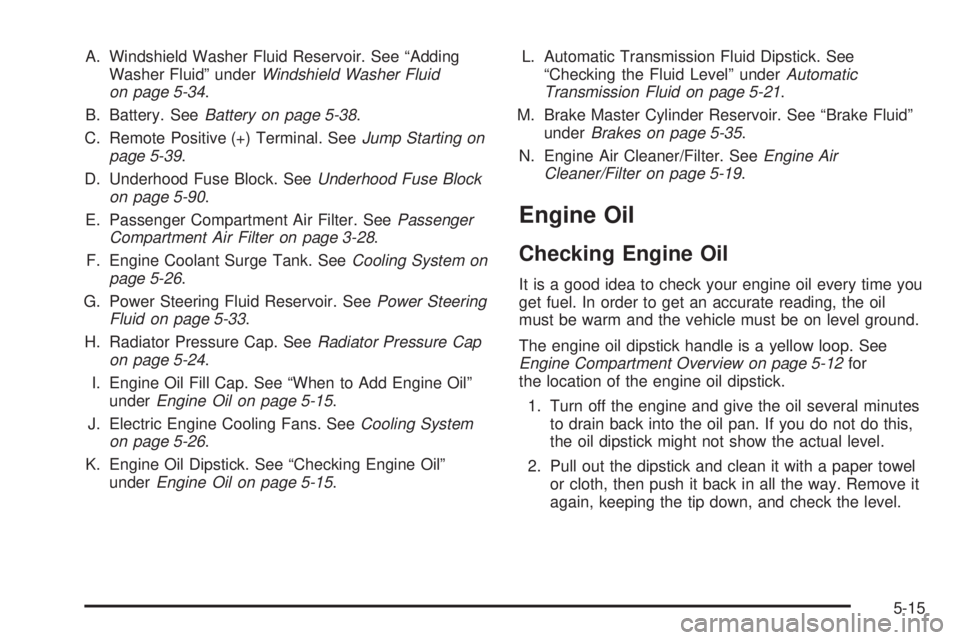
A. Windshield Washer Fluid Reservoir. See “Adding
Washer Fluid” underWindshield Washer Fluid
on page 5-34.
B. Battery. SeeBattery on page 5-38.
C. Remote Positive (+) Terminal. SeeJump Starting on
page 5-39.
D. Underhood Fuse Block. SeeUnderhood Fuse Block
on page 5-90.
E. Passenger Compartment Air Filter. SeePassenger
Compartment Air Filter on page 3-28.
F. Engine Coolant Surge Tank. SeeCooling System on
page 5-26.
G. Power Steering Fluid Reservoir. SeePower Steering
Fluid on page 5-33.
H. Radiator Pressure Cap. SeeRadiator Pressure Cap
on page 5-24.
I. Engine Oil Fill Cap. See “When to Add Engine Oil”
underEngine Oil on page 5-15.
J. Electric Engine Cooling Fans. SeeCooling System
on page 5-26.
K. Engine Oil Dipstick. See “Checking Engine Oil”
underEngine Oil on page 5-15.L. Automatic Transmission Fluid Dipstick. See
“Checking the Fluid Level” underAutomatic
Transmission Fluid on page 5-21.
M. Brake Master Cylinder Reservoir. See “Brake Fluid”
underBrakes on page 5-35.
N. Engine Air Cleaner/Filter. SeeEngine Air
Cleaner/Filter on page 5-19.
Engine Oil
Checking Engine Oil
It is a good idea to check your engine oil every time you
get fuel. In order to get an accurate reading, the oil
must be warm and the vehicle must be on level ground.
The engine oil dipstick handle is a yellow loop. See
Engine Compartment Overview on page 5-12for
the location of the engine oil dipstick.
1. Turn off the engine and give the oil several minutes
to drain back into the oil pan. If you do not do this,
the oil dipstick might not show the actual level.
2. Pull out the dipstick and clean it with a paper towel
or cloth, then push it back in all the way. Remove it
again, keeping the tip down, and check the level.
5-15
Page 295 of 410
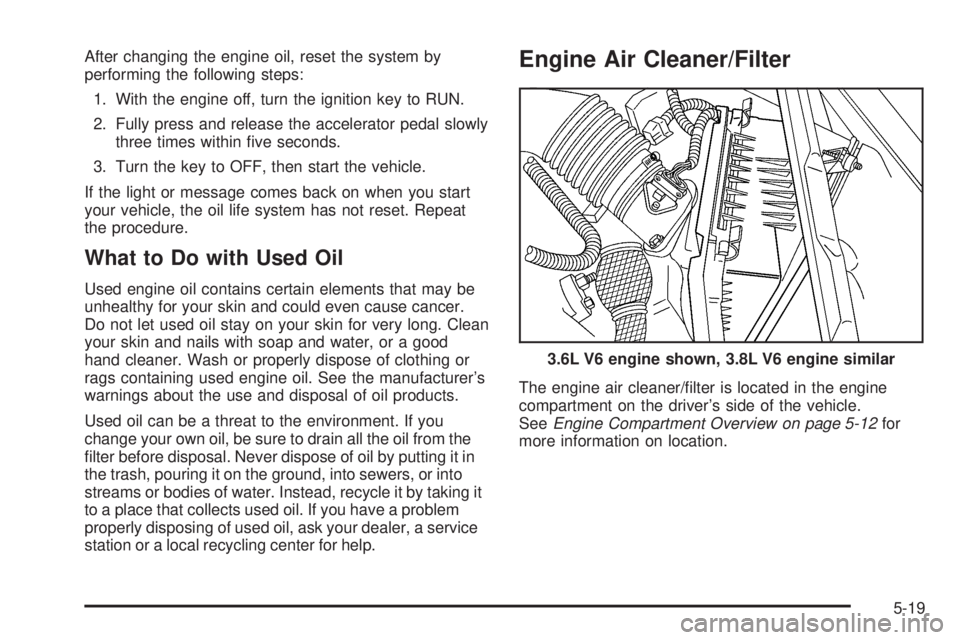
After changing the engine oil, reset the system by
performing the following steps:
1. With the engine off, turn the ignition key to RUN.
2. Fully press and release the accelerator pedal slowly
three times within �ve seconds.
3. Turn the key to OFF, then start the vehicle.
If the light or message comes back on when you start
your vehicle, the oil life system has not reset. Repeat
the procedure.
What to Do with Used Oil
Used engine oil contains certain elements that may be
unhealthy for your skin and could even cause cancer.
Do not let used oil stay on your skin for very long. Clean
your skin and nails with soap and water, or a good
hand cleaner. Wash or properly dispose of clothing or
rags containing used engine oil. See the manufacturer’s
warnings about the use and disposal of oil products.
Used oil can be a threat to the environment. If you
change your own oil, be sure to drain all the oil from the
�lter before disposal. Never dispose of oil by putting it in
the trash, pouring it on the ground, into sewers, or into
streams or bodies of water. Instead, recycle it by taking it
to a place that collects used oil. If you have a problem
properly disposing of used oil, ask your dealer, a service
station or a local recycling center for help.
Engine Air Cleaner/Filter
The engine air cleaner/�lter is located in the engine
compartment on the driver’s side of the vehicle.
SeeEngine Compartment Overview on page 5-12for
more information on location.3.6L V6 engine shown, 3.8L V6 engine similar
5-19
Page 296 of 410
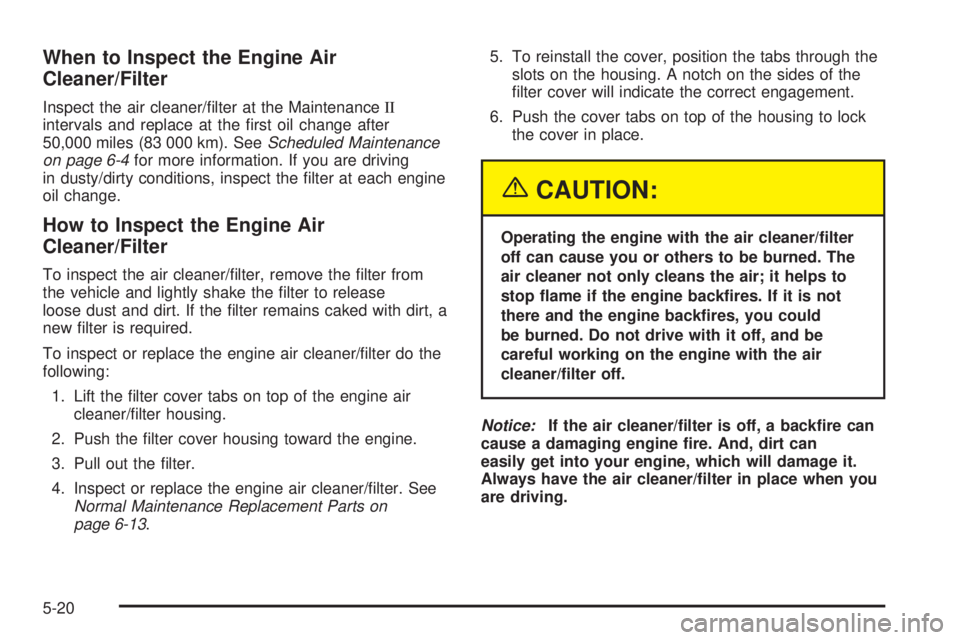
When to Inspect the Engine Air
Cleaner/Filter
Inspect the air cleaner/�lter at the MaintenanceII
intervals and replace at the �rst oil change after
50,000 miles (83 000 km). SeeScheduled Maintenance
on page 6-4for more information. If you are driving
in dusty/dirty conditions, inspect the �lter at each engine
oil change.
How to Inspect the Engine Air
Cleaner/Filter
To inspect the air cleaner/�lter, remove the �lter from
the vehicle and lightly shake the �lter to release
loose dust and dirt. If the �lter remains caked with dirt, a
new �lter is required.
To inspect or replace the engine air cleaner/�lter do the
following:
1. Lift the �lter cover tabs on top of the engine air
cleaner/�lter housing.
2. Push the �lter cover housing toward the engine.
3. Pull out the �lter.
4. Inspect or replace the engine air cleaner/�lter. See
Normal Maintenance Replacement Parts on
page 6-13.5. To reinstall the cover, position the tabs through the
slots on the housing. A notch on the sides of the
�lter cover will indicate the correct engagement.
6. Push the cover tabs on top of the housing to lock
the cover in place.
{CAUTION:
Operating the engine with the air cleaner/�lter
off can cause you or others to be burned. The
air cleaner not only cleans the air; it helps to
stop �ame if the engine back�res. If it is not
there and the engine back�res, you could
be burned. Do not drive with it off, and be
careful working on the engine with the air
cleaner/�lter off.
Notice:If the air cleaner/�lter is off, a back�re can
cause a damaging engine �re. And, dirt can
easily get into your engine, which will damage it.
Always have the air cleaner/�lter in place when you
are driving.
5-20
Page 368 of 410
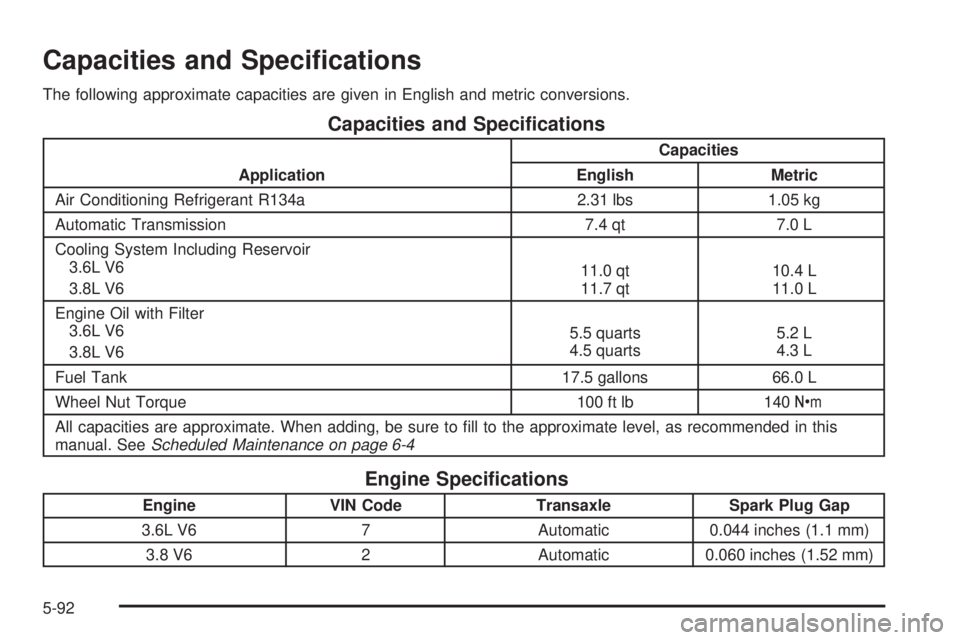
Capacities and Speci�cations
The following approximate capacities are given in English and metric conversions.
Capacities and Speci�cations
ApplicationCapacities
English Metric
Air Conditioning Refrigerant R134a 2.31 lbs 1.05 kg
Automatic Transmission 7.4 qt 7.0 L
Cooling System Including Reservoir
3.6L V6
3.8L V611.0 qt
11.7 qt10.4 L
11.0 L
Engine Oil with Filter
3.6L V6
3.8L V65.5 quarts
4.5 quarts5.2 L
4.3 L
Fuel Tank 17.5 gallons 66.0 L
Wheel Nut Torque 100 ft lb 140Y
All capacities are approximate. When adding, be sure to �ll to the approximate level, as recommended in this
manual. SeeScheduled Maintenance on page 6-4
Engine Speci�cations
Engine VIN Code Transaxle Spark Plug Gap
3.6L V6 7 Automatic 0.044 inches (1.1 mm)
3.8 V6 2 Automatic 0.060 inches (1.52 mm)
5-92
Page 373 of 410

Scheduled Maintenance
Service MaintenanceIMaintenanceII
Change engine oil and �lter. SeeEngine Oil on page 5-15. Reset oil life system.
SeeEngine Oil Life System on page 5-18.An Emission Control Service.••
Visually check for any leaks or damage.See footnote (k).••
Inspect engine air cleaner �lter. If necessary, replace �lter. SeeEngine Air
Cleaner/Filter on page 5-19.An Emission Control Service. See footnotes †
and (l).•
Rotate tires and check in�ation pressures and wear. SeeTire Inspection and
Rotation on page 5-60.••
Inspect brake system.See footnote (a).••
Check engine coolant and windshield washer �uid levels and add �uid
as needed.••
Perform any needed additional services. See “Additional Required Services” in
this section.••
Inspect suspension and steering components.See footnote (b).•
Inspect engine cooling system.See footnote (c).•
Inspect wiper blades.See footnote (d).•
Inspect restraint system components.See footnote (e).•
Lubricate body components.See footnote (f).•
Check transaxle �uid level and add �uid as needed.•
Replace passenger compartment air �lter.See footnote (g).•
Inspect throttle system.See footnote (j).•
6-5
Page 381 of 410

Normal Maintenance Replacement Parts
Replacement parts identi�ed below by name, part number, or speci�cation can be obtained from your GM dealer.
Normal Maintenance Replacement Parts
Part GM Part NumberACDelco
®Part
Number
Engine Air Cleaner/Filter 24508572 A1614C
Engine Oil Filter
3.6L V6
3.8L V812587552
25010792PF61
PF47
Passenger Compartment Air Filter 10340216 —
Spark Plugs
3.6L V6 Engine
3.8L V8 Engine12565996
1256838741-988
41-101
Windshield Wiper Assembly
22.0 inches (56.0 cm) 10350320—
6-13
Page 401 of 410
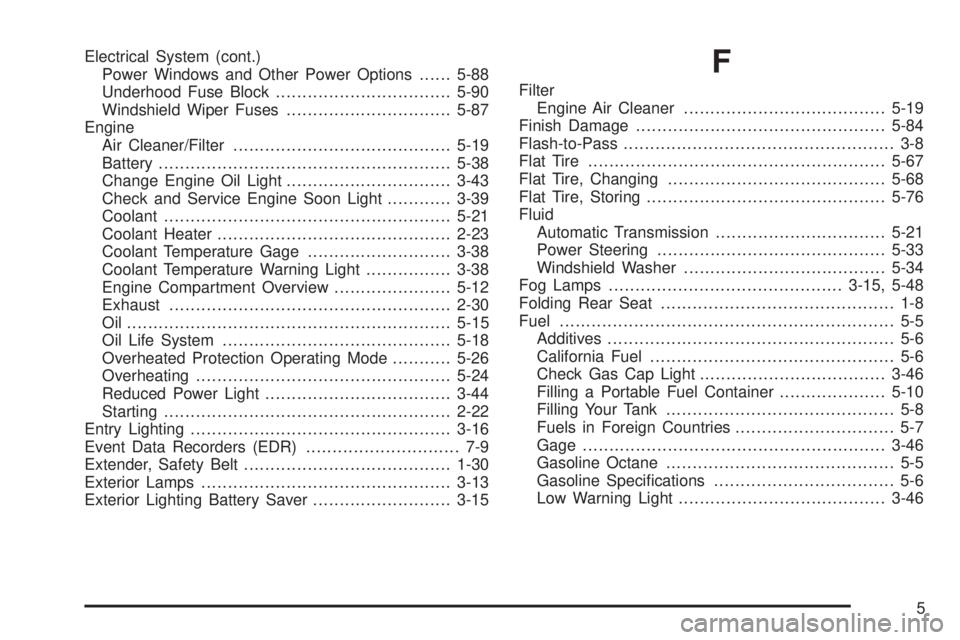
Electrical System (cont.)
Power Windows and Other Power Options......5-88
Underhood Fuse Block.................................5-90
Windshield Wiper Fuses...............................5-87
Engine
Air Cleaner/Filter.........................................5-19
Battery.......................................................5-38
Change Engine Oil Light...............................3-43
Check and Service Engine Soon Light............3-39
Coolant......................................................5-21
Coolant Heater............................................2-23
Coolant Temperature Gage...........................3-38
Coolant Temperature Warning Light................3-38
Engine Compartment Overview......................5-12
Exhaust.....................................................2-30
Oil .............................................................5-15
Oil Life System...........................................5-18
Overheated Protection Operating Mode...........5-26
Overheating................................................5-24
Reduced Power Light...................................3-44
Starting......................................................2-22
Entry Lighting.................................................3-16
Event Data Recorders (EDR)............................. 7-9
Extender, Safety Belt.......................................1-30
Exterior Lamps...............................................3-13
Exterior Lighting Battery Saver..........................3-15F
Filter
Engine Air Cleaner......................................5-19
Finish Damage...............................................5-84
Flash-to-Pass................................................... 3-8
Flat Tire........................................................5-67
Flat Tire, Changing.........................................5-68
Flat Tire, Storing.............................................5-76
Fluid
Automatic Transmission................................5-21
Power Steering...........................................5-33
Windshield Washer......................................5-34
Fog Lamps............................................3-15, 5-48
Folding Rear Seat............................................ 1-8
Fuel............................................................... 5-5
Additives...................................................... 5-6
California Fuel.............................................. 5-6
Check Gas Cap Light...................................3-46
Filling a Portable Fuel Container....................5-10
Filling Your Tank........................................... 5-8
Fuels in Foreign Countries.............................. 5-7
Gage.........................................................3-46
Gasoline Octane........................................... 5-5
Gasoline Speci�cations.................................. 5-6
Low Warning Light.......................................3-46
5
Page 405 of 410
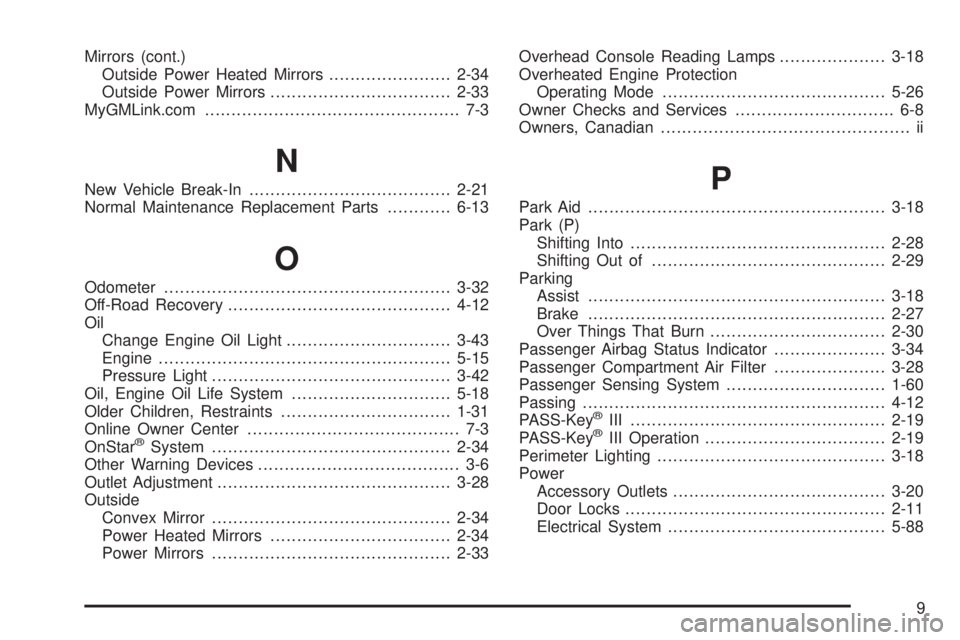
Mirrors (cont.)
Outside Power Heated Mirrors.......................2-34
Outside Power Mirrors..................................2-33
MyGMLink.com................................................ 7-3
N
New Vehicle Break-In......................................2-21
Normal Maintenance Replacement Parts............6-13
O
Odometer......................................................3-32
Off-Road Recovery..........................................4-12
Oil
Change Engine Oil Light...............................3-43
Engine.......................................................5-15
Pressure Light.............................................3-42
Oil, Engine Oil Life System..............................5-18
Older Children, Restraints................................1-31
Online Owner Center........................................ 7-3
OnStar
®System.............................................2-34
Other Warning Devices...................................... 3-6
Outlet Adjustment............................................3-28
Outside
Convex Mirror.............................................2-34
Power Heated Mirrors..................................2-34
Power Mirrors.............................................2-33Overhead Console Reading Lamps....................3-18
Overheated Engine Protection
Operating Mode..........................................5-26
Owner Checks and Services.............................. 6-8
Owners, Canadian............................................... ii
P
Park Aid........................................................3-18
Park (P)
Shifting Into................................................2-28
Shifting Out of............................................2-29
Parking
Assist........................................................3-18
Brake........................................................2-27
Over Things That Burn.................................2-30
Passenger Airbag Status Indicator.....................3-34
Passenger Compartment Air Filter.....................3-28
Passenger Sensing System..............................1-60
Passing.........................................................4-12
PASS-Key
®III ................................................2-19
PASS-Key®III Operation..................................2-19
Perimeter Lighting...........................................3-18
Power
Accessory Outlets........................................3-20
Door Locks.................................................2-11
Electrical System.........................................5-88
9